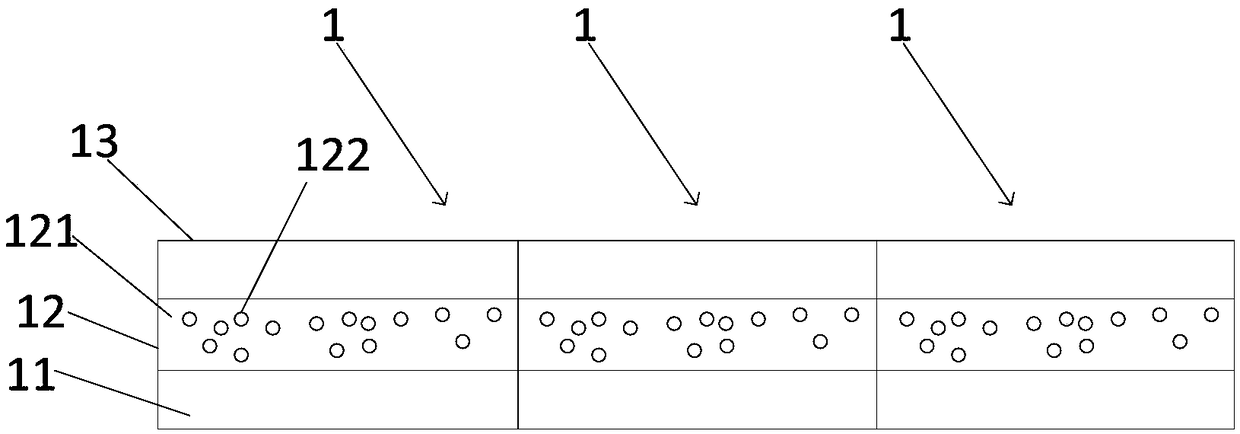Organic electroluminescent device
An electroluminescence device and luminescence technology, applied in circuits, electrical components, electric solid-state devices, etc., can solve the problems of heavy synthesis workload, high research and development costs, and low luminous efficiency, and achieve improved luminous efficiency and expanded color gamut Area, the effect of increasing the color gamut area
- Summary
- Abstract
- Description
- Claims
- Application Information
AI Technical Summary
Problems solved by technology
Method used
Image
Examples
Embodiment 1
[0079] The embodiment of the present invention provides a specific example of an organic electroluminescence device. The organic electroluminescent device in this embodiment includes monochromatic organic light emitting diodes with three light emitting wavelengths, namely red organic light emitting diodes, green light organic light emitting diodes and blue light organic light emitting diodes. Among them, the three organic light emitting diodes all have a microcavity structure.
[0080] Each organic light-emitting diode includes a first electrode layer, a light-emitting layer and a second electrode layer stacked in sequence, and the light-emitting layer includes a host material and a guest material, the host material includes a thermal activation delay (TADF) material, and the guest material is fluorescent material.
[0081] Wherein, the host material in the light-emitting layer of the red organic light-emitting diode includes a thermally activated delay (TADF) material, and i...
Embodiment 2
[0092] The embodiment of the present invention provides a specific example of an organic electroluminescent device. Its structure is the same as embodiment 1, and the difference with the organic electroluminescent device that embodiment 1 provides is:
[0093] The device of red organic light-emitting diode adopts the traditional host CBP and the phosphorescent guest Ir(piq) 3 , the device of blue-light red-light organic light-emitting diode adopts the traditional host CBP and the fluorescent guest DPVBi.
[0094] The device structure of the red organic light-emitting diode in this embodiment is: ITO (10nm) / Ag (100nm) / ITO (10nm) / CuPc (20nm) / TPD (200nm) / CBP:Ir (piq) 3 (1%,30nm) / TPBi(40nm) / LiF(1nm) / Mg:Ag(20%,15nm) / NPB(60nm)
[0095] The device structure of the blue light organic light emitting diode in the present embodiment is: ITO (10nm) / Ag (100nm) / ITO (10nm) / CuPc (20nm) / TPD (100nm) / CBP:DPVBi (1%, 30nm) / TPBi ( 40nm) / LiF(1nm) / Mg:Ag(20%,15nm) / NPB(60nm)
Embodiment 3
[0097] The embodiment of the present invention provides a specific example of an organic electroluminescent device. Its structure is the same as embodiment 1, and the difference with the organic electroluminescent device that embodiment 1 provides is:
[0098] The mass ratio of the host material and the guest material in the light-emitting layer of the organic light-emitting diode with three light-emitting wavelengths is 95:5.
PUM
 Login to View More
Login to View More Abstract
Description
Claims
Application Information
 Login to View More
Login to View More - R&D
- Intellectual Property
- Life Sciences
- Materials
- Tech Scout
- Unparalleled Data Quality
- Higher Quality Content
- 60% Fewer Hallucinations
Browse by: Latest US Patents, China's latest patents, Technical Efficacy Thesaurus, Application Domain, Technology Topic, Popular Technical Reports.
© 2025 PatSnap. All rights reserved.Legal|Privacy policy|Modern Slavery Act Transparency Statement|Sitemap|About US| Contact US: help@patsnap.com



